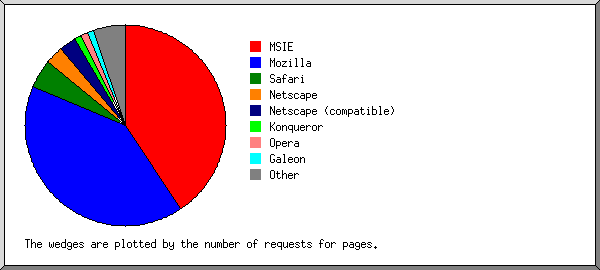Browser Stats
I know the readership of this blog is not exactly a typical cross-section of blog readers generally, let alone of web-surfers as a whole. But I thought I’d share with you the past 10 days (5600 page retrievals, after eliminating robots, RSS newsreaders and other crud) of stats for this blog.
First, the breakdown of page accesses by browser:

As you can see, Mozilla and Internet Explorer are neck and neck, with 40% each. Safari is next with 5%, and everyone else trails well behind.
The breakdown by operating system was also interesting:

Windows was tops at 52%, followed by Unix (almost exclusively Linux) at 22% and MacOS at 18%.
But, as I said, maybe the readership of this blog is not all that representative. To get a more representative sample, I decided to look at the subset which arrived here via a google search (700 searches). Their browser breakdown looked like this:

They were 67% IE, 13% Mozilla and 10% Safari users. And their OS breakdown:

was 72% Windows, 15% MacOS and 12% Unix (again, almost exclusively Linux).
Several things surprised me here.
- I didn’t expect that the overall percentage of IE user among my readership would be as high (40%) as it is. Reading this blog in IE seems like an exercise in masochism. Until I saw the numbers, I was sure I had fewer masochist-readers.
- I didn’t expect that the percentage of IE users among the google searchers (a more-or-less random cross-section of web surfers) would be as low (67%) as it is. I’d swallowed whole the propaganda that 98% of web surfers are using IE. But try as I might: eliminate all searches involving Macintosh-related keywords, focus only on users running Windows, … I could never come even close to 98%.
- The Mozilla figure includes Firebird, but not Camino, which is counted separately. Frankly, I was surprised at how few Camino users there are. I got more hits from Lynx users than from Camino. I think this is bad news for the Camino project.
- Linux is bigger on the desktop than most people seem to think. And the Macintosh ain’t doing so bad either.
I don’t know whether any of this means anything to those fretting over the fallout from the Eolas Patent Suit, but it makes me want to hum Don’t worry, be happy!
Posted by distler at October 10, 2003 2:02 AM

Re: Browser Stats
I don’t want to spoil the fun, but the hits you’re getting via Google are not very representative for the average Google search either… let alone the entire internet.
As you can see on Google’s “Zeitgeist”, only 1% of the hits Google gets is from Linux users.
The percentage of Mozilla users isn’t something to be excited about either, in my opinion.
It’s a mixed up world we live in…